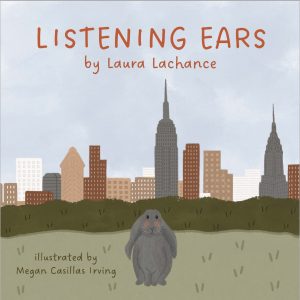UConn Graduate Authors Book to Aid Communication Development – UConn Today


Laura Lachance: A Speech Pathologist’s Journey to Help Children with Speech Development
Laura Lachance earned her master’s degree from UConn in speech and language pathology in 2016. Lachance is a speech pathologist at Brooklyn Technical High School in New York City. She also works with younger clients through her private practice, The Talk Shop. Her educational children’s book, “Listening Ears,” was published last year and aims to help children with their speech development. Lachance recently took some time to visit with UConn Today about her book.
What made you decide to write this book?


As a speech therapist, I am always looking for materials to use in my own sessions to work on early language skills. My goal was to create something that other speech providers and parents could use with their kids too. I typically come across picture cards and worksheets, but I wanted a way to work on these foundational skills that was much more interactive and story-based.
I wanted to write a book about nonverbal communications because one of my nieces has a rare genetic mutation, DDX3X syndrome, which can have severe impacts on physical, cognitive, and communication development. Some people who have this syndrome, including my niece, are nonverbal, so it was especially important for me to write an inclusive book that showed readers that you can communicate without words.
Also, and this is why I went into speech pathology in general, I was extremely shy growing up, so it took me a while to successfully communicate. So, I’ve always been drawn to helping other people find their voice, for whatever reason they are having difficulty.
What is the book about?
It’s a story about a bunny named Simon that lives in New York City, who needs to get to a magic show in Central Park. On each page readers use their “listening ears” to copy Simon’s gestures and actions to travel to the next New York landmark, like Grand Central Station, a Broadway show, and the Met Museum. The book ends with Simon in the magic show. The main character is based on my real pet bunny. I thought it would be fun to write a book about him having an adventure in New York City, where we live.
The book is perfect for children ages 2 to 5. If someone is struggling with learning language skills, then it could be used for those a bit older.
What types of nonverbal language can this book help with?
Facial expressions, body language, and carrying out actions. So, for example, pointing, clapping, and smiling – those are all early examples of functional nonverbal language. Typically, a child learns to imitate nonverbal gestures before they are able to imitate words, so the book helps with gaining that foundational skill. There’s also been a lot of research showing that toddlers who use more gestures tend to develop a larger vocabulary and have stronger language skills as they grow older. The book can be used with children with special needs – “late talkers,” as we call them – who have a language delay, and typically developing kids.
What was the writing process for this book like?
I first came up with 30 examples of early gestures and actions that are functional for communicating wants and needs. Then I created a narrative around those so that the child could learn to imitate the actions in a story-based context. I reached out to a graphic artist, Megan Casillas Irving, on social media. I was drawn to her illustration style and was so excited to see how she brought Simon and my favorite places in New York to life. “Listening Ears” is available on Amazon. It’s also for sale at Greenlight Bookstore in Brooklyn, one of my favorites.
Tell us about your time as a UConn graduate student.
UConn’s speech master’s program gave me a great foundation for my career. The program set me up with externships in medical and educational settings, like Connecticut Children’s Medical Center, so I was able to get a lot of hands-on experience.
Are you going to write another book?
I hope so! I would love to write more books using Simon that focus on different speech and language topics.
SDGs, Targets, and Indicators
| SDGs | Targets | Indicators |
|---|---|---|
| SDG 4: Quality Education | 4.4 By 2030, substantially increase the number of youth and adults who have relevant skills, including technical and vocational skills, for employment, decent jobs, and entrepreneurship | Number of individuals who have acquired relevant skills for employment and entrepreneurship |
| SDG 10: Reduced Inequalities | 10.2 By 2030, empower and promote the social, economic, and political inclusion of all, irrespective of age, sex, disability, race, ethnicity, origin, religion, or economic or other status | Proportion of the population with access to basic services, including education and healthcare |
| SDG 17: Partnerships for the Goals | 17.17 Encourage and promote effective public, public-private, and civil society partnerships, building on the experience and resourcing strategies of partnerships | Number of partnerships formed to support the achievement of sustainable development goals |
1. Which SDGs are addressed or connected to the issues highlighted in the article?
SDG 4: Quality Education
The article discusses the creation of an educational children’s book, “Listening Ears,” aimed at helping children with their speech development. This aligns with SDG 4, which focuses on ensuring inclusive and equitable quality education and promoting lifelong learning opportunities for all.
SDG 10: Reduced Inequalities
The article mentions that the book is inclusive and aims to show readers that communication can happen without words. This connects to SDG 10, which aims to reduce inequalities and promote the social, economic, and political inclusion of all individuals, irrespective of their abilities or status.
SDG 17: Partnerships for the Goals
The author mentions collaborating with a graphic artist and having the book available for sale at a bookstore. This highlights the importance of partnerships and aligns with SDG 17, which emphasizes the need for effective partnerships to achieve sustainable development goals.
2. What specific targets under those SDGs can be identified based on the article’s content?
Target 4.4: By 2030, substantially increase the number of youth and adults who have relevant skills, including technical and vocational skills, for employment, decent jobs, and entrepreneurship.
The creation of the book “Listening Ears” aims to help children with their speech development, which can be considered a relevant skill for communication and language. By providing resources like this book, the target of increasing the number of individuals with relevant skills for employment and entrepreneurship can be supported.
Target 10.2: By 2030, empower and promote the social, economic, and political inclusion of all, irrespective of age, sex, disability, race, ethnicity, origin, religion, or economic or other status.
The book “Listening Ears” is inclusive and aims to show that communication can happen without words. By promoting the inclusion of all individuals, irrespective of their abilities, the target of empowering and promoting social inclusion can be addressed.
Target 17.17: Encourage and promote effective public, public-private, and civil society partnerships, building on the experience and resourcing strategies of partnerships.
The author mentions collaborating with a graphic artist and having the book available for sale at a bookstore. This demonstrates the formation of partnerships between different stakeholders, such as the author, the artist, and the bookstore, to promote the book and its message. This aligns with the target of encouraging and promoting effective partnerships.
3. Are there any indicators mentioned or implied in the article that can be used to measure progress towards the identified targets?
The article does not explicitly mention specific indicators to measure progress towards the identified targets. However, potential indicators that can be used include:
- Number of individuals who have acquired relevant skills for employment and entrepreneurship (for measuring progress towards Target 4.4)
- Proportion of the population with access to basic services, including education and healthcare (for measuring progress towards Target 10.2)
- Number of partnerships formed to support the achievement of sustainable development goals (for measuring progress towards Target 17.17)
4. SDGs, Targets, and Indicators
| SDGs | Targets | Indicators |
|---|---|---|
| SDG 4: Quality Education | 4.4 By 2030, substantially increase the number of youth and adults who have relevant skills, including technical and vocational skills, for employment, decent jobs, and entrepreneurship | Number of individuals who have acquired relevant skills for employment and entrepreneurship |
| SDG 10: Reduced Inequalities | 10.2 By 2030, empower and promote the social, economic, and political inclusion of all, irrespective of age, sex, disability, race, ethnicity, origin, religion, or economic or other status | Proportion of the population with access to basic services, including education and healthcare |
| SDG 17: Partnerships for the Goals | 17.17 Encourage and promote effective public, public-private, and civil society partnerships, building on the experience and resourcing strategies of partnerships | Number of partnerships formed to support the achievement of sustainable development goals |
Source: today.uconn.edu








